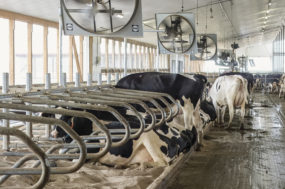It’s time; it’s time for an intervention – no, not with that crazy nephew that makes a few too many visits to Colorado – a genetic intervention.
What could be wrong, you ask? The dairy cow has made tremendous strides in the last 75 years due to the great work of producers, the A.I. industry and dairy geneticists. Cows produce more milk than ever before. Great job. So what’s the problem? What’s the message?
Stop breeding for larger cows
All right, I’m a nutritionist and a consultant on farms; I’m not a geneticist, but neither are dairy producers and they have seen the same results that I do. Do I need to state the obvious? Cows have been getting bigger.
If you look at the young genome-tested sires (1,497 bulls) being used in the dairy industry today, 97 percent of them are positive for stature. Positive is good, right? Well, no, positive means the bulls being used today will result in cows that are bigger tomorrow.
With the current sire lineups, cows will be larger in three years than they are today. There are only 47 bulls out of 1,497 that are negative for stature.
Not sure about that? Page through your shiny catalog, use your favorite search engine or talk to your genetic consultant. How many bulls can you find that are negative for stature? And by the way, what does that really mean?
So why care about cow size?
Over the last decade or so, a consensus seems to have been reached that large-statured cows do not have the same longevity as small-statured cows. The exact reasons for this are a little vague. Do our facilities not accommodate large cows?
Do larger cows have more health issues due to sheer weight? Are the hooves of dairy cows just not designed to carry a 2,000-pound cow? Even in the show ring, the largest cow doesn’t always win anymore.
A more important reason to care about cow size is the issue of cow comfort. As our cows have gotten larger, they have outgrown our facilities. A 48-inch stall simply does not accommodate a 2,000-pound cow. So … build facilities with bigger stalls? Wait, didn’t we just agree that large cows are not desirable?
When a dairymen builds a new facility, it will be there for a while. Many have culled those large cows that do not fit into their stalls; they want a cow that fits comfortably in their current facilities. That not only refers to freestalls but the parlor as well.
Rotary parlors are not designed for expansion. Going into some older parlors, I’m struck by the fact that some cows are simply too big for the parlors. This impedes cow flow, cow comfort and labor efficiency. What will the parlors built today look like in 10 years with larger cows?
In the world of nutrition, cattle size is important. The start of every ration for a cow is the first entry: average cow size. As a nutritionist, I know all nutritionists lie. We don’t really know the average weight on the farm (except on those few farms with robots). Cow size determines intake, energy requirements, protein requirements, etc. Many nutritionists would argue large cows are less efficient, but that research is elusive.
So what do dairymen want (or need)? Rather than saying small or large, the right word might be consistency or predictability. There have been many dairymen that have been utilizing crossbreeding.
Many producers are looking to impact reproduction, longevity and profitability. But there are also some producers looking for a more reasonably sized animal. At times, these herds have a lot of inconsistency in cow size that creates problems, but the cows are generally smaller.
So why do we continue to progress toward larger cows? Remember, cows will be larger in three years than they are today; this is a certainty. I think there are a couple reasons for this.
First, bulls being selected for A.I. are higher in stature. What is the relationship to genomics here? Isn’t everything based on indexes? Hmmm ... do we still have an influence from the show ring to commercial cattle? Frankly, I don’t know.
Second is the problem of communication. When doing statistics (the first love of all geneticists, I believe), cattle traits need to be quantified and analyzed. Linear type traits have been developed and have changed the way cows look today through mating programs. Gone are the pendulous udders, and in are the perfectly shaped bovines.
However, what does it mean when stature is +1.0? Anyone? Is that a 1,300-pound, 1,500-pound or 2,000-pound cow? I know a few analytical folks out there are going to start thinking means, standard deviations, trends, etc.
But tell me, how big is that cow with a +1.0 stature (or pick your metric), and will she fit into my 48-inch stall? Or should I just use some Jersey semen? This lack of communication is the real problem. Statistics have gotten in the way of communication.
A simple solution
It’s time we started communicating more effectively with dairy producers. Instead of expressing the size of cattle in statistical terms, let’s use terms producers can relate to. For every bull that is entering the A.I. industry, let’s give a value that is understandable. Maybe something really technical like mature bodyweight (with a fancy, easy-to-remember acronym like MBW).
The publication of these understandable values would likely cause more change than a standard deviation from the mean. If a producer sits down with a geneticist tomorrow, and he knows the mature bodyweight of the sire lineup, what do you think he will do? Yes, he’s going to say, “I want a cow between 1,450 and 1,550 pounds, please.”
Can we go one step further (yes, now we’ll make it complicated)? What is the two-year bodyweight (2BW)? With the importance of 2-year-olds in many herds, perhaps this would be a useful target as well. If I calve all heifers at 2 years old, can I breed a group of animals that would be very similar in size? Can I predict genetically that all my 2-year-olds are going to be 1,350 pounds?
We can go further, of course. What is the average age of maturity (AAM); when do they reach mature bodyweight? We know that Jerseys reach maturity (and mature weight) faster than Holsteins. It’s probably the reason we can successfully breed Jerseys at younger ages (they are physiologically mature at a younger age).
Can we move this number for a breed? If we reduce average age of maturity, could we reduce the average age at first breeding for heifers? Combined with good nutrition, could we successfully and consistently calve heifers at 18 to 20 months? Yes, this sounds too good to be true. Talk to the poultry producers. That has been their focus for layers and broilers for years.
Does this make sense? Can we really change our genetic evaluations? Do we need to? Cows will be larger in three years than they are today. Do you want that? Time for a genetic intervention. PD
References omitted due to space but are available upon request. Click here to email an editor.

-
Paul Dyk
- Dairy Technical Service, Manager
- Quality Liquid Feeds
- Email Paul Dyk






